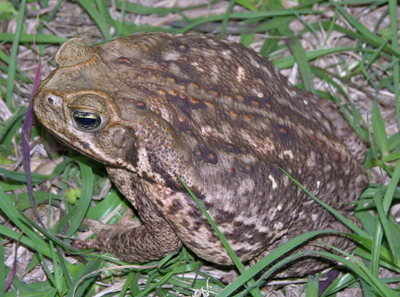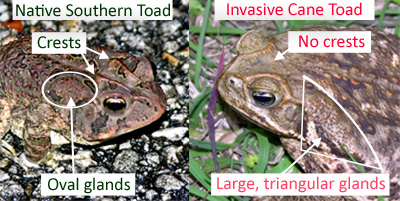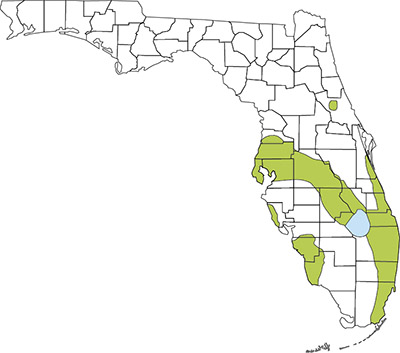Florida's Frogs & Toads
True Toads (Family Bufonidae)
_________________________________________________________
INVASIVE SPECIES
Cane Toad (Rhinella marina [formerly Bufo marinus])
a.k.a. "Bufo Toad", Marine Toad, or Giant Toad
Watch this video to learn more about how to accurately identify toads in Florida - https://www.youtube.com/watch?v=RMzLes3BaCo.
Watch this video to learn more about Bufo toads in Florida and how to treat a family pet that encounters a bufo toad - https://www.youtube.com/watch?v=Cg1HUuxM7Zc.
Watch this video to learn how to capture and humanely euthanize invasive bufo toads on your property - https://www.youtube.com/watch?v=JCZlSVbOkWU.
Cane Toad (click on comparison image to view larger)
Photo by Dr. Steve A. Johnson (UF). To obtain permission to use this photo for educational purposes, email tadpole@ufl.edu.
Impacts:
Ecological - Cane Toads prey on native frogs, lizards, snakes, small mammals, and just about anything else that fits into their mouths.
Human Health/Quality of Life - Cane Toad toxin can irritate your skin and eyes. If your pet bites or swallows a Cane Toad, it will become sick and may die -- take it to the vet right away! Symptoms of Cane Toad poisoning in pets include excessive drooling and extremely red gums, head-shaking, crying, loss of coordination, and sometimes convulsions.
Size:
Usually 4 to 6 in. (max. ~9.5 in.) Note: With very few exceptions, any toad in Florida that is larger than 4 inches is NOT native and is almost certainly an invasive Cane Toad.
Identification
Body is tan to reddish-brown, dark brown, or gray; back is marked with dark spots. Skin is warty. Large, triangular parotoid glands are prominent on the shoulders; parotoid glands of native "true" toads are oval. Unlike native Southern Toads, they DO NOT have ridges or "crests" on top of the head.
Note: In the known range of these toads, it is a good idea to catch and identify ANY toad you see in your yard to be sure that they aren't dangerous. Humanely euthanize any Cane Toads you find by rubbing or spraying 20% benzocaine toothache gel or sunburn spray (not 5% lidocaine) on the toad's lower belly. In a few minutes, it will become unconscious. Put the frog in a sealed plastic bag it in the freezer for 24-48 hours to ensure that it is humanely euthanized before disposal.
Breeding:
March to September; eggs are laid in long strings, virtually indistinguishable from eggs of native "true" toads. Call is a slow, melodic trill. To hear the Cane Toad's call, click here (choose to open file if asked). To hear other frog calls, visit the USGS Frog Call Lookup and select the species you want to hear from the common name drop-down list.
Diet:
Beetles, centipedes, crabs, millipedes, roaches, scorpions, spiders, and other invertebrates; also frogs, small reptiles, small birds, and small mammals.
Habitats:
Native to Central and South America.
Established in much of the central and southern peninsula including the Keys. A small population persists in Deland, Volusia Co. There are several one-off records from northern Florida and the panhandle, but cane toads are not established there. An isolated population used to occur in Panama City, but cold weather appears to have caused its extirpation. Found predominantly in urbanized habitats and agricultural lands, but rarely natural areas such as floodplain and mangrove swamps. Breeds in the vegetated edges of any available freshwater habitat, including ponds (natural and manmade), lakes, canals, and ditches.
Note: Report any suspected Cane Toad sightings outside of the range shown in green to tadpole@ufl.edu.
Map by UF, IFAS Extension - may be used freely for education.
Go Back to Florida's Frogs - All Regions



